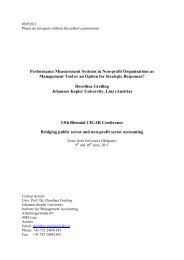A theoretical framework and classification of capability areas
A theoretical framework and classification of capability areas
A theoretical framework and classification of capability areas
Create successful ePaper yourself
Turn your PDF publications into a flip-book with our unique Google optimized e-Paper software.
2 Methodology<br />
2.1 Literature study (RQ1)<br />
The <strong>theoretical</strong> <strong>framework</strong> was rigorously built by an iterative <strong>and</strong> top-down approach. First, three<br />
relevant concepts in the business process literature were defined: (1) business process (BP), (2)<br />
business process management (BPM), <strong>and</strong> (3) business process orientation (BPO). We used clear <strong>and</strong><br />
accepted definitions to derive the <strong>capability</strong> <strong>areas</strong> that are related to these concepts. The BP, BPM,<br />
<strong>and</strong> BPO concepts were already used in the context <strong>of</strong> BPMMs [3,6,10]. Moreover, they are umbrella<br />
terms in contemporary business process literature. For instance, the radical business process<br />
reengineering or the incremental total quality management are two possible improvement approaches<br />
within BPM. Hence, we built on the business process fundamentals, instead <strong>of</strong> being biased by the<br />
lacking consensus on <strong>capability</strong> <strong>areas</strong> <strong>and</strong> the manifold BPMMs.<br />
Afterwards, this high-level perspective was refined in sub <strong>areas</strong>. Besides relying on the broader<br />
literature on business processes, we used validated theories to underpin the findings. Since BPMMs<br />
aim to improve business processes throughout their lifecycle, we relied on established theories<br />
regarding the traditional business process lifecycle. We must note that this lifecycle differs from a<br />
one-<strong>of</strong>f project lifecycle, e.g. Prince2 [19] or the Rational Unified Process [20], in which project<br />
stages are defined to realise a particular process change [21]. We also looked for recognised<br />
organisation management theories in the field <strong>of</strong> (1) performance <strong>and</strong> change management, (2) human<br />
resource management, <strong>and</strong> (3) strategic management. This link is appropriate, since most<br />
organisational changes also involve business processes [22]. Moreover, BPMMs aim to gradually<br />
increase business (process) performance [23].<br />
2.2 Sampling (RQ2 <strong>and</strong> RQ3)<br />
The resulting <strong>capability</strong> <strong>areas</strong> <strong>and</strong> sub <strong>areas</strong> were empirically validated by mapping them to a sample<br />
<strong>of</strong> existing BPMMs. To fully acknowledge prior BPMM efforts, we compare the <strong>theoretical</strong>ly found<br />
<strong>areas</strong> that a BPMM ‘can address’ with the empirically found <strong>areas</strong> that BPMMs ‘actually address’.<br />
Particularly, our purpose is to <strong>theoretical</strong>ly ground the <strong>capability</strong> <strong>areas</strong> in BPMMs.<br />
Data was collected during the second quarter <strong>of</strong> 2010. We initially searched for articles in academic<br />
databases (i.e. SCI-Exp<strong>and</strong>ed, SSCI, A&HCI, CPCI-S, CPCI-SSH, BPM Journal) <strong>and</strong> non-academic<br />
search engines (i.e. Google, Google Scholar) by using the combined keywords <strong>of</strong> ‘process’ <strong>and</strong><br />
‘maturity’. Then, we traced the references in the identified articles to get access to other relevant<br />
sources. Given the proliferation <strong>of</strong> BPMMs [7], the research scope was set to generic business<br />
processes. Also supply chains <strong>and</strong> collaboration processes were included to examine crossorganisational<br />
value chains.<br />
In total, 69 BPMMs were collected, listed in appendix A: (1) 37 BPMMs for generic business<br />
processes (13 academic <strong>and</strong> 24 non-academic), (2) 24 BPMMs for supply chains (9 academic <strong>and</strong> 15<br />
non-academic), <strong>and</strong> (3) 8 BPMMs for process collaboration (6 academic <strong>and</strong> 2 non-academic). By<br />
including non-academic BPMMs, our sample is larger than most comparative studies on BPMMs<br />
[14]. Furthermore, by including different process types (i.e. generic, supply chains, collaboration), our<br />
sample suggests versatility which facilitates transferability <strong>of</strong> our findings to other process types, e.g.<br />
s<strong>of</strong>tware processes.<br />
2.3 Content analysis <strong>and</strong> descriptive statistics (RQ2)<br />
The documents <strong>of</strong> the collected BPMMs were repeatedly analysed over time, beginning in the third<br />
quarter <strong>of</strong> 2010 until the second quarter <strong>of</strong> 2011. The first author was the main coder. In case <strong>of</strong> any

















